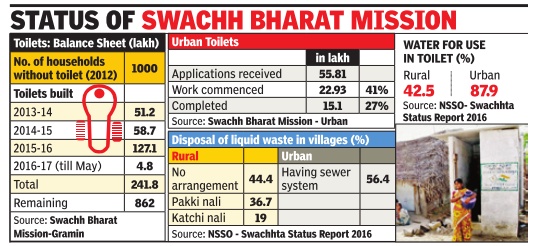Swachh Bharat Mission
This is a collection of articles archived for the excellence of their content. |
Contents |
Implementation status
2014-16: Status
The Times of India, May 30 2016

Subodh Varma
The central government has spent Rs 9,093 crore on building about 1.8 crore toilets across the country under the Swachh Bharat Mission since October 2014.This is because Prime Minister Modi has made the drive a priority. The mission also envisages a cleaner India at large, although this part of the plan is hazy.
The question that arises now is -how is this frenzy of toilet-building changing the situation on the ground? After nearly one-and-a-half years, there should be some concrete evaluation. Sadly , there is no comprehensive study . Ashok Kumar Jain, adviser in the NITI Aayog and an expert on the programme, told TOI that a study will be conducted in the coming days because the World Bank, which has given a $1.5-billion loan for the programme, wants an evaluation.
Meanwhile, the National Sample Survey Organisation (NSSO) came out with a `Swachhata Status Report' earlier this year. Findings listed in the report, especially those concerned with water use and drainage of liquid waste, give a glimpse of how the programme is performing on the ground.
According to the NSSO report, just 42.5% of rural households have “water for use in toilets“. This is a critical factor that can make or break the most well-laid plans. And, this is not something new that has been discovered recently . Decades of toilet-building have -presumably -taught policymakers that without making arrangements for water the toilets will be useless. In urban areas, the situation is vastly different with nearly 88% households having water for use in toilets.
The second critical component for use of toilets is drainage. This is often not of immediate concern to households but should be high up on the policymakers' priority list. Because the whole point of having toilets would be defeated if effluents from it are just spreading out into fields or village ponds. And this is what appears to be happening on a large scale.
The NSSO report says that a staggering 44.4% of villages have no arrangement for the disposal of liquid waste. It doesn't spell out further details as to what is happening to the toilets in these villages. It would be safe to presume that residents don't use them.
What about the remaining 55.6% of the villages? Of these, 36.7% have what the report quaintly records as a “pakki nali“ while 19% have a “katchi nali“. These are drains, one lined with concrete or bricks, the other just channels dug into the soil.And where are these “nalis“ leading to? The report says that about 16% drain into local ponds, 24% into the local “nala“, and about 7% into a local river.
The situation in urban areas is worse. Although 56.4% of households are using toilets connected to the sewer network, most of the sewage goes straight into the rivers.
Swachh Bharat Mission- Gramin (SBM-G)
2014-Oct 2019/ prevented 3 lakh deaths
WHO thumbs up for Swachh Bharat’s rural component, August 3, 2018: The Hindu
It is estimated that the Swachh Bharat Mission Gramin (SBM-G) will result in preventing more than three lakh deaths due to diarrhoea and protein-energy malnutrition between 2014-October 2019, notes a World Health Organisation (WHO) report.
The progress report on potential health impact from increased sanitation coverage through the SBM-G, conducted by the WHO for the Ministry of Drinking Water and Sanitation, said India’s rural sanitation coverage escalated to 89.07% till August 2.
The report notes that under the SBM-G, 19 States and Union Territories were declared Open Defecation Free (ODF) and 7.9 crore toilets were built, while 421 districts were declared ODF. Also, more than 4.9 lakh villages in the country were declared ODF.
The WHO study showed that before the initiation of SBM-G, unsafe sanitation caused 199 million cases of diarrhoea annually and that by 2019, the initiative aims to achieve 100% sanitation coverage.
Union Health secretary Preeti Sudan, speaking at the release of the report, said, “WHO has only highlighted what we have known and are working towards. Sanitation and health are deeply related and the Ministry has several schemes running parallel to ensure good health coverage reaches all.”
Risk assessment
The report further estimated that 14 million Disability Adjusted Life Years (DALYs) can be avoided between 2014 and 2019. WHO estimation of health impacts is based on comparative risk assessment (CRA) methods.